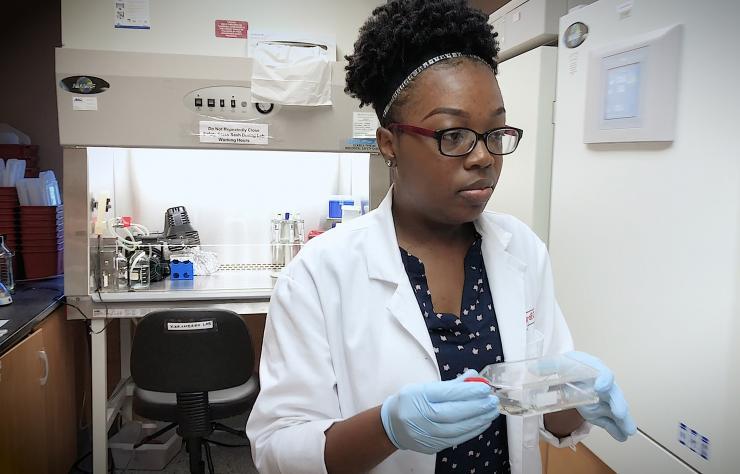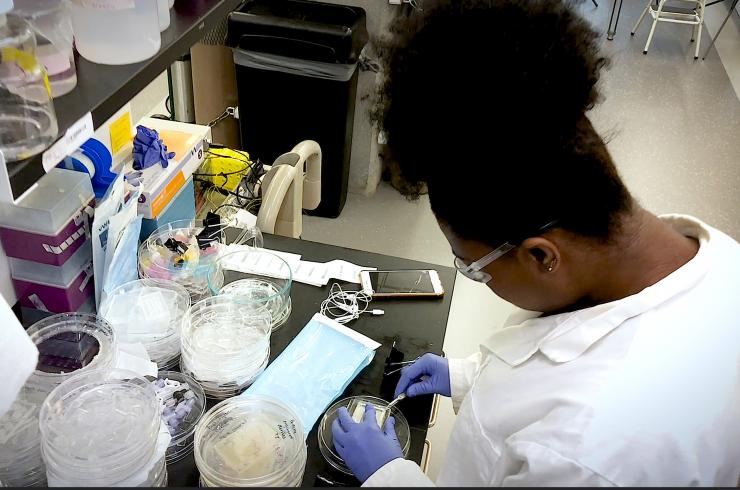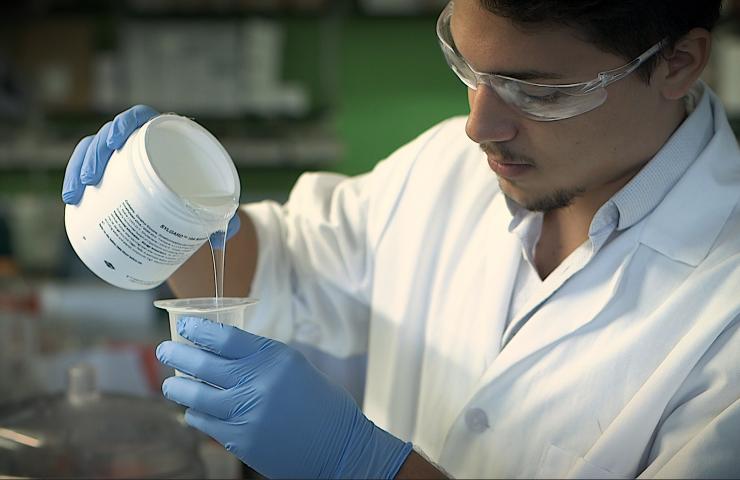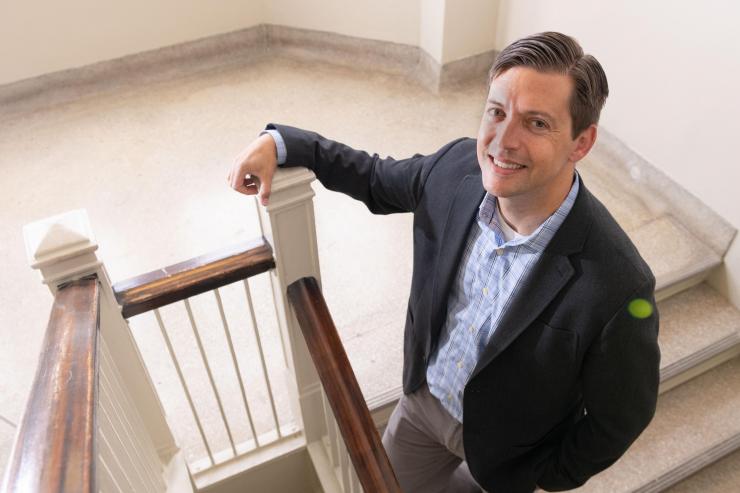Summer Lab Experience Helps Launch Industry and Research Careers
Sep 15, 2018 — Atlanta, GA

Yasmine Stewart, a biology major from Savannah State University, worked in the laboratory of Lohitash Karumbaiah, assistant professor in the College of Agricultural & and Environmental Sciences at the University of Georgia. (Credit: Brice Zimmerman, Georgia Tech)
Sofía Hernández-Torres spent her summer working to optimize a testing device that will be used to measure muscle strength in mice that have an animal model of muscular dystrophy. The testing will help a research team at the Georgia Institute of Technology advance cell-based therapies for fighting the disease, an inherited X-linked disorder diagnosed in one in 3,500 people worldwide.
“I am in love with the work that I’m doing,” she said. “We are looking at extending the lifespan and improving the quality of life. Being in the lab and working with diseases that are affecting people around the world is what I want to do with my life.”
Hernández, an industrial biotechnology major at the University of Puerto Rico at Mayagüez, spent 10 weeks this summer in the laboratory of Andrés García, the Rae and Frank H. Neely Chair in the George W. Woodruff School of Mechanical Engineering and the executive director of the Petit Institute for Bioengineering and Bioscience at Georgia Tech. The opportunity came through the National Science Foundation’s Research Experience for Undergraduates (REU) program, which supported her work through the NSF Engineering Research Center for Cell Manufacturing Technologies (CMaT), also headquartered at Georgia Tech.
As one of 14 students working in cell therapy and manufacturing labs at the University of Georgia, the University of Wisconsin-Madison and Georgia Tech during the summer, Hernández received hands-on experience with cutting-edge research, and said she hopes to be part of the health care revolution that CMaT is helping to create.
“Cell therapy is an emerging field and CMaT’s goal is to make it scalable, high quality and affordable,” she explained. “Working in a project that aims to make this type of treatment available is very important to me.”
Workforce Development a Key Part of CMaT
Students have traditionally not received much research-based experience until they enter graduate school. The NSF’s REU effort is helping to change that by giving undergraduates an opportunity to work in advanced research labs alongside top graduate students and pioneering researchers in a broad range of fields. By giving them an idea of what it’s like to participate in the development of cutting-edge therapies and new technologies, the program is helping develop the next generation of research leaders.
“Educational programs at all levels are critical, of course, and the REU program bringing undergraduates into CMaT labs is important for introducing these students to the excitement of new cell therapies and cell manufacturing,” said Aaron Levine, CMaT’s co-director for workforce development and a professor in Georgia Tech’s School of Public Policy. “Developing the future workforce has been identified as a critical issue for cell manufacturing to succeed. The CMaT workforce programs are critical to our success — and for the industry to reach its full potential.”
The students applied for the REU at CMaT and were assigned both a university principal investigator and a mentor for the summer. Beyond the lab experiences, the students learn collaboration, networking and other key skills.
“This is a unique and impactful REU program focused on cell manufacturing research that has successfully engaged an impressive cohort of students, many from underrepresented groups in STEM," said Mary Poats, REU program manager in NSF’s Division of Engineering Education and Centers. “The students are engaged early on in state-of-the-art ERC research and innovation activities that are directed toward a goal of curing disease and illnesses throughout the world. It is rewarding to hear these students passionately describe how being a part of CMaT’s summer REU program has so positively impacted their desire to further pursue related engineering and science academic studies, along with careers in the health care industry.”
After a summer working in the laboratory of Hang Lu, the Love Family Professor in Georgia Tech’s School of Chemical and Biomolecular Engineering, Tailynn McCarty, says she’d like to get some experience in industry before going on to graduate school. A chemical engineering major from the University of Rhode Island, she hopes her experience with optimizing culture procedures for cellular aggregates — large groups of cells measured in three dimensions instead of just two — might open a corporate door.
“CMaT is providing an opportunity to save lives,” she said. “I’ve wanted to help people for a very long time, and I didn’t know exactly how I would do that. The work that CMaT is doing will allow me and other people to develop cures for illnesses to reduce the large impact of disease.”
NSF REU Gives Students Early Experience in Research
A key goal of the REU program is to give students a taste of what they’ll experience working in a research lab, whether that’s in a traditional academic setting or in industry. That goal appealed to Eva Gatune, who is working on dual degrees in biology and biomedical engineering at Xavier University of Louisiana.
“As undergraduates, we’re looking to the future and to graduate school — what we’ll do next,” she said. “This is the perfect preview to tell us if this is something we want to do or not.”
During the summer REU, Gatune worked in the laboratory of Georgia Tech Biomedical Engineering Professor Manu Platt studying cathepsins, enzymes that degrade proteins in the body. Specifically, she worked on how cathepsins and their protein networks affect breast cancer — and found that experience inspiring.
“Not a lot of young people would get an opportunity like this,” she said. “It’s heartwarming and fascinating to be part of something that is bigger than you. In the next 10 years, who knows how far this is going to go?”
For Yasmine Stewart, a biology major from Savannah State University, the REU program provided an opportunity to participate in one of the most exciting areas of life sciences research today: cell therapies. She worked with graduate students in the laboratory of Lohitash Karumbaiah, assistant professor in the College of Agricultural & Environmental Sciences at the University of Georgia, learning cell culture techniques.
“We all have loved ones who suffer from diseases, so I’m especially passionate about doing my part to help them,” she said. “I’ve learned a lot of things in the lab, as far as cell culturing, but I’ve also learned patience, how to read research articles and to study more. I’ve learned how to work with others in the lab.”
Stewart had been considering an M.D.- Ph.D. path, but her experience using microfluidics technology to study potential cell treatments made the research track more intriguing. “The CMaT program is important because it is going to improve health care,” she said.
Getting in on the Ground Floor of an Exciting Technology
Kailyn Cleaves saw the summer REU as an opportunity to “get outside my comfort zone and do things I had never done before.” A biochemistry and pre-med major from the University of Tennessee-Knoxville, she enjoyed the lab experience and, like other students, found involvement in the early stages of cell manufacturing to be both exciting and rewarding.
“I felt intimidated at first because I had never worked in a lab before,” she said. But she quickly found that graduate students in the laboratory of Steven Stice, director of the University of Georgia’s Regenerative Bioscience Center, enjoyed helping her and providing mentoring.
For David Frey, a Georgia Tech second-year student majoring in biomedical engineering, working in the lab of Krishnendu Roy, CMaT executive director and Robert A. Milton Chair, unlocked a “dream come true.” Frey worked on a microfluidics project that could lead to improvements in the way cells are cultured. The technology could also help match therapies to a patient’s specific disease characteristics.
“It’s truly been a dream come true,” he said. “I’ve always wanted to be in the lab all day. But being in school, I could never do that. This program definitely helps you immerse yourself in the research you are doing.”
As with others in the program, Frey was excited about being part of the cell manufacturing initiative in its early stages.
“It’s exciting being a pioneer with this specific technology,” he said. “Every day you want to see what the final product will look like. You want to see that the technology is being used for medical purposes. This could potentially help thousands of people someday.”
Making Cell Therapies Widely Available and Affordable
The companies that will bring cell therapies to the clinic will create a broad range of new jobs, everything from Ph.D. researchers developing new technologies to production staff and quality control specialists responsible for manufacturing cells of consistent quality and efficacy. Developing a new workforce to handle those divergent tasks is a key element of the CMaT initiative.
“Many of the REU students will go into industry, and they will come out of this lab experience with a better understanding of what industry needs and what sorts of skills are important for both industry and academic researchers,” Levine explained. “We deliberately structure our projects to have faculty and students from multiple institutions, often with industry partners. This is really how the real world works today — assembling the best teams to advance knowledge.”
Therapies based on living cells are different from traditional drug-based treatments, having great promise but also significant challenges.
“Most of the medical treatments we have now are much simpler, relying on small molecules or biologics,” Levine said. “The idea behind cell therapies is that cells can be much more powerful to treat conditions that are currently not treatable. Many of the conditions that we struggle with have to do with cellular dysfunction. The hope is that cell therapy can emerge as a way to replace or repair those cells.”
However, living cells can be affected by small changes in their environment and as they are transported to the clinics where they will be used. Ensuring consistency is another of the major challenges ahead, one for which Georgia Tech is applying its expertise in manufacturing and process control.
Only a small number of cellular therapies have been approved for use in the United States, and many more are in the research pipeline. But these therapies are often expensive — sometimes costing hundreds of thousands of dollars per patient. Making these affordable for use by ordinary patients is yet another challenge that CMaT is taking on.
“By developing better technologies to manufacture cells more reliably, more safely and more inexpensively, we hope to lower the cost of these therapies and make cell therapy more widely accessible,” Levine explained. “The students participating in this program will be thrust into a field where the opportunities are growing dramatically. Preparing them to understand what the potential is and what the trends are like in this field is what we believe we’ve accomplished this summer.”
The NSF Engineering Research Center for Cell Manufacturing Technologies was established to create new integrated manufacturing innovations and advanced bioprocessing technologies to enable robust, scalable, low-cost bio-manufacturing of high-quality therapeutic cells. CMaT has established cellular testbeds in three areas: (1) Mesenchymal stem cells (MSCs) to repair, regenerate and restore diseased tissues and organs, (2) Engineered T cells to treat some forms of cancer, and (3) Induced pluripotent stem cell (IPSC)-derived cardiomyocytes to treat heart disease.
Research News
Georgia Institute of Technology
177 North Avenue
Atlanta, Georgia 30332-0181 USA
Media Relations Contact: John Toon (404-894-6986) (jtoon@gatech.edu).
Writer: John Toon

Tailynn McCarty is a chemical engineering major from the University of Rhode Island. She worked in the laboratory of Hang Lu, the Love Family Professor in Georgia Tech’s School of Chemical and Biomolecular Engineering. (Credit: Brice Zimmerman, Georgia Tech)

Sofía Hernández-Torrres is an industrial biotechnology major at the University of Puerto Rico at Mayagüez. She spent 10 weeks this summer in the laboratory of Andrés García, the Rae and Frank H. Neely Chair in the George W. Woodruff School of Mechanical Engineering and the executive director of the Petit Institute for Bioengineering and Bioscience at Georgia Tech. (Credit: Brice Zimmerman, Georgia Tech)

David Frey is a Georgia Tech second-year student majoring in biomedical engineering. He worked in the lab of Krishnendu Roy, executive director of the NSF Engineering Research Center for Cell Manufacturing Technologies and Robert A. Milton Chair. (Credit: Brice Zimmerman, Georgia Tech)

Aaron Levine is co-director for workforce development in the NSF Engineering Research Center for Cell Manufacturing Technologies and a professor in Georgia Tech’s School of Public Policy. (Credit: Rob Felt, Georgia Tech)
John Toon
Research News
(404) 894-6986




